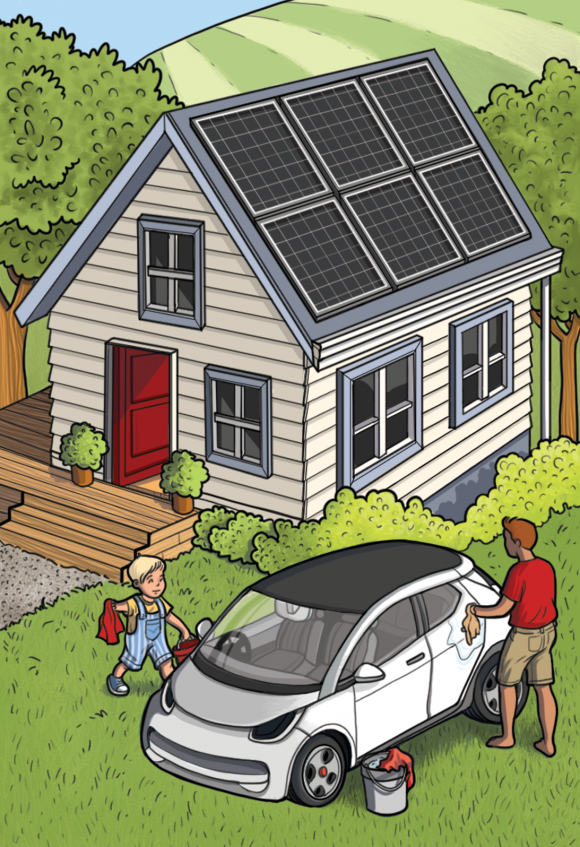Buildings Better Adapted

| Seeking to Rent, Buy or Build a New Home? | Useful as climate adaptation | As emission mitigation. |
|---|---|---|
If selecting an older home to rent or to buy, either avoid pre-2008 builds, unless upgraded, from the viewpoint of low energy efficiency or be ready to upgrade them, provided the roof, wall and floor structure allows strength and space to add extra insulation (get a builder to inspect it). Insurers will not cover wear-and-tear or slowly developing faults such as small leaks in a building, so pro-active home maintenance is important to keep it dry and warm. See EQC’s guide: https://www.eqc.govt.nz/our-publications/maintaining-your-home-brochure/ | Weather patterns are changing. Better-insulated homes with some internal thermal mass (such as an insulated concrete floor) and adequate shading above North and West double-glazed windows, tend to overheat less in summer and be warmer in winter. Ensuring good ventilation reduces condensation and stops harmful black mould forming. How healthy is your home? Try the Home Fit online tool: https://genless.govt.nz/for-everyone/at-home/do-a-healthy-home-check/ Summer droughts could bring increased fire risk. It’s sensible to have some space around your home clear of dry vegetation, and to keep gutters and spaces below outdoor decks clear, to reduce risk from blown embers. | Insulation values required from 2021 Building Code are much higher than pre-2008, so investment in a more-recently-built home or making insulation improvements in an older one improves energy efficiency. Replace oil or gas fuelled heating with electric heat pumps or modern woodstoves to cut emissions considerably. https://www.ecan.govt.nz/your-region/your-environment/air-quality/home-heating/ For fuel use efficiency, ensure firewood is kept dry and the wood-burner design is ultra-low-emission. |
Avoid sites for new building close to coast or floodable valleys. If you are building, request the District Council LIM (Land Information Memorandum) report for the house location. This will tell you if your Council has classified a hazard risk there. (Fee applies) Environment Canterbury can provide a site Flood Hazard Assessment (Fee applies). https://www.ecan.govt.nz/do-it-online/property-information/flood-hazard-assessments/ Timaru District Proposed Plan maps of hazards. Including future coastal erosion and inundation, are available free online: https://www.timaru.govt.nz/services/planning/district-plan/proposed-district-plan/proposed-district-plan/how-to-use-the-e-plan | If you have questions to help understand flood probabilities, see this page from Environment Canterbury: https://www.ecan.govt.nz/your-region/your-environment/natural-hazards/floods/flood-probabilities/ Home location well above coast or river levels means you are less likely to need emergency rescue from flood or to pay for expensive after-flood-repairs; and more likely to remain commercially insurable in future. Insurance companies are retreating from providing building cover in high-risk locations. Read more: Select a house to rent with similar care. A flood-prone rental location will affect cost or availability of contents insurance, for example. https://www.canstar.co.nz/home-contents-insurance/water-flood-damage-what-does-insurance-cover/ | Also reduces potential waste of building materials, if wrecked in floods or landslips, which otherwise should have a long use-life. Materials such as steel, concrete and gypsum (such as GIB) wallboard have a high carbon footprint ‘embodied’ in their manufacture, so you’d prefer them to last 50+ years. See a summary of what this means for architecture, engineering and construction in NZ. https://www.level.org.nz/material-use/embodied-energy/ Building Industry tools from BRANZ are available here. https://www.branz.co.nz/environment-zero-carbon-research/framework/ |
| Design climate-smart new homes & home renovations to have: - better insulation in walls, roof and windows (including window frames). - less glazing overall, reduced area especially at West (to cut summer overheating) and South (to reduce winter chill). - Eaves or external shading above north-facing windows. adequate steam-ventilation fans (from bathroom, kitchen and laundry), - Consider adding internal thermal mass (overnight heat store) in a mid-day sun-lit interior brick or concrete wall and/or tiled floor area on concrete, insulated below. Read more: https://www.ecodesignadvisor.org.nz/resources/ | Homes and workplaces need to be better able to cope with the extremes of summer heat to have more comfortable overnight temperature. Houses will need extra summer shade above north-facing windows and improved cross-ventilation to reduce overheating (intake low at shaded south and output high at sunny north) They also require better moist-air ventilation all year to tackle the increased humidity expected with climate change, to ensure less condensation or mould on cold surfaces indoors. Reducing the outside sealed (waterproof) areas of pathways and vehicle hard-standing which gather rainwater into pipes, cuts your potential contribution to flooding ‘downstream’. Permeable surfaces such as gravel or surface blocks with drainage holes replenish water in the soil. Let water seep in, spread out and sink down, to be accessible for trees and shrubs nearby. Read more on managing stormwater: https://www.building.govt.nz/getting-started/smarter-homes-guides/water-and-waste/managing-stormwater | Houses built to the 2021 Building Code, require less energy to heat comfortably, so carbon emissions and costs from heating are reduced. Don’t use oil-burners, gas or coal for home heating. If using wood burners, with their ‘renewable’ fuel, they have to be Ultra Low Emissions Burners to protect air quality. Older homes can be brought up to and preferably beyond that 2021 Building Code. To assess how easily your owned or rented home could be kept warm with insulation, dry and safe, use the free online Homefit check: https://homefit.org.nz/ Individual ‘healthy’ new homes can be designed to a Homestar rating: https://www.buildmagazine.org.nz/assets/PDF/Build-185-66-Feature-High-performance-Buildings-Homestar-V5.pdf Commercial buildings in NZ can be built and fitted out to a low-carbon standard using Green Star rating. https://nzgbc.org.nz/introduction-to-green-star |
Last updated: 04 Jun 2024